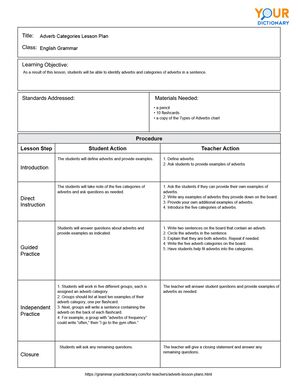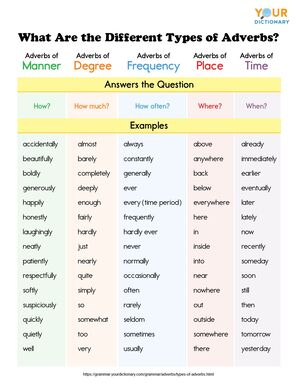

Adverbs are one of the most important parts of speech, yet sometimes they are difficult to define. You can change this with some easy and fun adverbs lesson plans!
Adverb Categories Lesson Plan
Before you get started teaching your upper elementary or middle school students about adverbs, create a lesson plan that works best for you. You can view resources on creating a lesson plan of your own, or use this adverb categories lesson plan template with instructions to get you started.

Learning Objective
As a result of this lesson, students will be able to identify adverbs and categories of adverbs in a sentence.
Materials Needed
For this lesson, each student will need:
a pencil
10 flashcards
a copy of the Types of Adverbs chart

Adverbs Different Types
Click to View & DownloadAdverb Categories Lesson Plan Instruction
Once you have created your lesson plan and gathered your materials, you are ready to teach your students about adverbs.
Direct Instruction
Students will likely have questions about adverbs, so answer them as needed and be prepared to give examples. The “Types of Adverbs” chart above lists many.
Ask your students if they know what an adverb is.
Explain and define what an adverb is, and teach some tricks for how to recognize adverbs (Example Tip: if the word answers the questions of when, where, how much, it’s probably an adverb).
Ask the students if they can provide their own examples of adverbs.
On the board, write any examples of adverbs they provide.
Provide your own additional examples of adverbs.
Introduce the five categories of adverbs: manner, degree, frequency, place, and time.
Guided Practice
After students have a solid understanding of adverbs, move on to guided practice.
Begin by writing two sentences on the board that each contain one adverb, such as “Tommy ran swiftly” and “Today, we went to the store.”
Circle the words “swiftly” and “today.”
Ask if your students know what the similarity between the two words is. If no one knows the correct answer, explain that they are both adverbs.
Correct any mistakes that they make, and answer any questions that they may have.
Write two or more additional sentences, using some of the examples the students provided previously.
Write the following categories on the board: How?, When?, Where?, How Much?, and How Often?.
Choose a few adverbs from the direct instruction part of the lesson, and ask students which category each adverb falls into.
Write each adverb under the correct category. If one category becomes too full, encourage students to fill up the other categories.
When writing the sample sentences, you can enlist the help of students to write the sentences. For example, if a student gave an example of an adverb, ask if they would like to write the sentence containing that adverb.
Independent Practice
Pass out the flashcards, and ask your students to form small groups. The size of these groups will vary depending on how many students there are. If there is just one student, ask them to work independently.
Once you have at least ten adverbs under each category, break the students up into five groups (if applicable).
Assign each group a category, and encourage them to come up with a list of ten additional adverbs for that category. If you’re only working with one child, have them come up with two additional adverbs for each category.
Have the students write the adverbs on the flashcards. They will write the adverb on one side and a sentence using it on the other side. Encourage them to complete the activity without consulting the chart.
Collect the flashcards, mark any corrections and clarify any misunderstandings that the children might have.
At the end of the lesson, ask the students if they have any more questions and answer them accordingly. Give a closing statement reiterating information about adverb categories.
Plans for the Future
As you begin your lesson, take note of what worked for you, what didn’t and what you would like to implement in the future. For further reference, use some expert tips for writing lesson plans. You can also consult other lesson plans for inspiration.